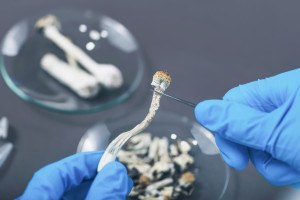Harvard’s Bionic Leaf Generates Energy Faster Than Actual Plants

Bionic leaf screenshot via YouTube/Harvard University
Researchers at Harvard may have found a way to one-up nature. A system they developed, called the Bionic Leaf 2.0, can mimic photosynthesis up to 10 times more efficiently than an actual plant, according to a paper published in Science.
The artificial leaf, which looks more like a microchip, uses hydrogen-eating bacteria and solar energy to make sustainable fuel. When placed in water with direct access to sunlight, the leaf splits water molecules into hydrogen and oxygen. The bacteria then turns the hydrogen into liquid fuels, including isopropanol. The upshot? The leaf might offer a new way to create clean, carbon-neutral fuel out of solar energy.
“If you think about it, photosynthesis is amazing,” Daniel Nocera, a Harvard professor who spearheaded the project, said in a statement. “It takes sunlight, water, and air—and then look at a tree. That’s exactly what we did, but we do it significantly better, because we turn all that energy into a fuel.”
Mimicking photosynthesis—generally seen as the gold standard of renewable energy—is no small feat, particularly in the realm of sustainable fuel. Nocera believes that science used in his bionic leaf might eventually begin replacing dirtier energy sources, such as diesel. And since the leaf can create clean, sustainable energy out of any form of water—including dirty and polluted water—and carbon dioxide is abundantly available in the atmosphere, harnessing this artificial “breathing” process on a large scale may indeed be plausible.
“It’s an important discovery—it says we can do better than photosynthesis,” Nocera said in the statement. “But I also want to bring this technology to the developing world as well.”
As such, the researchers plan next to explore the bionic leaf’s potential as an inexpensive fuel source in developing countries, such as India, as well as for clean commercial uses in the United States. Watch Nocera discuss the idea, below:


